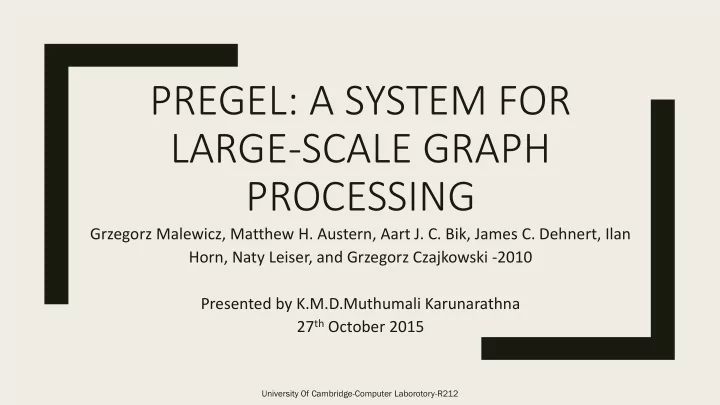

PREGEL: A SYSTEM FOR LARGE-SCALE GRAPH PROCESSING Grzegorz Malewicz, Matthew H. Austern, Aart J. C. Bik, James C. Dehnert, Ilan Horn, Naty Leiser, and Grzegorz Czajkowski -2010 Presented by K.M.D.Muthumali Karunarathna 27 th October 2015 University Of Cambridge-Computer Laborotory-R212
Outline ■ Problem ■ Current Solutions ■ Limitations of current solutions ■ Pregel ■ Future work University Of Cambridge-Computer Laborotory-R212
Problem Billions of vertices,Trillions of edges poses challenges to their efficient processing in large graphs. e.g. Web graphs Social Networks (Facebook, Twitter) University Of Cambridge-Computer Laborotory-R212
Frequently added algorithms ■ Shortest path computation ■ Different flavors of clustering (e.g. K-means, K-median) ■ PageRank theme (PageRank is a “vote”, by all the other pages on the Web, about how important a page is) University Of Cambridge-Computer Laborotory-R212
Problems with graph algorithms ■ Poor locality of memory access ■ Very little work per vertex ■ A changing degree of parallelism over the course of execution University Of Cambridge-Computer Laborotory-R212
Implementing an algorithm for a large graph ■ Crafting custom distributed infrastructure ■ Relying on an existing distributed computing platform like MapReduce ■ Using single computer graph algorithm library such as BGL, LEDA ■ Using an existing parallel graph system like BGL, CGMgraph None of this alternatives fit the author's purpose University Of Cambridge-Computer Laborotory-R212
Solution simply ■ A computational model, − Which expressed as a sequence of iterations − A vertex can receive messages sent in the previous iteration − Send messages to other vertices − Modify its own state and that of its outgoing edges ■ Efficient, Scalable, Fault tolerance implementation on clusters ■ Its implied synchronicity makes reasoning about programs easier University Of Cambridge-Computer Laborotory-R212
Model of computation ■ Consists of a sequence of iterations (supersteps), where the same user-defined function is executed for each vertex. ■ This function specifies behavior at a single vertex V and superset S. It can read messages sent to the vertex in super Steps-1, send messages to other vertices that will be read in superset S+1, and modify that state of V and its outgoing edges. University Of Cambridge-Computer Laborotory-R212
Vertex State Machine Vote to halt Active Inactive Message received • Initially each vertex is in an active state. Each vertex can ‘vote to halt’, where it runs no further computation in any further super step unless it receives a message from another vertex. ,It is then reactivated again and needs to explicitly vote to halt to deactivate itself again. Algorithm terminates when all vertices have halted. University Of Cambridge-Computer Laborotory-R212
Pregal - Find maximum value Superstep 0 3 6 2 1 Superstep 1 6 6 2 6 Superstep 2 6 6 6 6 Superstep 3 6 6 6 6 University Of Cambridge-Computer Laborotory-R212
Pregel Solution ■ Allows efficient processing of large, distributively-stored, graphs. ■ Abstracts away distributed computer related issues like fault tolerance . ■ A ‘vertex - centric system’ - All programmer needs to do is outline a single function. University Of Cambridge-Computer Laborotory-R212
Pregel in detailed ■ Master node 1. Coordinates and maintains a list of all workers. 2. Maintains aggregator ■ Aggregators 1. Nodes send master a value at each iteration for aggregation. 2. Provides a global statistic to each node at each super step, important for some algorithms like Dijkstra's algorithm University Of Cambridge-Computer Laborotory-R212
■ Combiners Combines messages to reduce message traffic. − ■ Input and outputs Can be generated from any arbitrary format and stored in a form most suitable for a given − application. ■ Fault tolerance. Achieved through checkpointing − Master instructs workers to save their state to persistent storage at the beginning of each − superstep (Vertex values, Edge values, Incoming messages) If Master detects these workers as down, it reassigns their partitions to available workers − and recomputes the superstep University Of Cambridge-Computer Laborotory-R212
Pregel example - SSSP University Of Cambridge-Computer Laborotory-R212
Experiments - SSSP with varying graph size and worker numbers Runtime (Seconds) Runtime (Seconds) Number of worker tasks Number of worker vertices Figure 9: SSSP — log-normal random graphs, mean out-degree Figure 7: SSSP — 1 billion vertex binary tree: varying number 127.1 (thus over 127 billion edges in the largest case): of worker tasks scheduled on 300 multicore machines varying graph sizes on 800 worker tasks scheduled on 300 multicore machines University Of Cambridge-Computer Laborotory-R212
Critical Analysis ■ What will happen if fault tolerance occurs and it’s not clear whether only the work for the reassigned graph partition or the entire work for that super step is recomputed? ■ They doesn't address when infinite loops might occur and how to account for them University Of Cambridge-Computer Laborotory-R212
Future Work ■ Partitioning based on the graph ■ Handle complex parallelizable functions over the whole graph ■ Avoid waiting for slow workers ■ Confined recovery to improve the cost and latency of recovery University Of Cambridge-Computer Laborotory-R212
THA THANK Y NK YOU OU University Of Cambridge-Computer Laborotory-R212
Recommend
More recommend